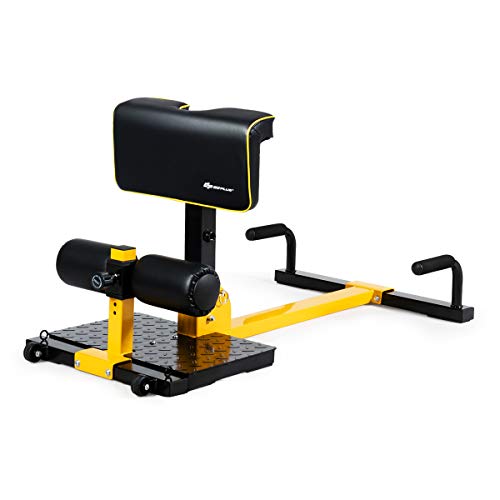If you want to learn more about sissy squat and the muscles worked while doing them, this is it!
Not many people know a lot about this strange-looking exercise, but the lucky ones that get to know it will gain big wins if used regularly!
Read on, and I’ll tell you all about what sissy squats are, how they work – and how you can effectively include them into your workout routine.
Contents
What Are Sissy Squats?
Sissy squats might not have the most macho-masculine name, but the movement can do wonders for you. Plus, sissy squats have an interesting origin.
The name of the movement comes from an old tale in Greek mythology. Sisyphus – the founder and ruler of Ephyra – enjoyed mischief. After cheating death twice and doing other bad things, Zeus punished Sisyphus. He presented him with a huge boulder and told him to push it up a hill. Once he made it to the top, Zeus would free him to live his life.
Unfortunately, each time Sisyphus pushed the boulder near the top, it would fall back down, leaving the rule of Ephyra to start all over.

Pushing the boulder up a hill certainly led Sisyphus to build a fantastic set of quadriceps, hence the name of this exercise. Luckily for all of us, sissy squats aren’t about pushing a giant rock up a mountain. Instead, the movement is much more accessible and not that difficult to learn. Plus, you can stop doing sissy squats whenever you like. There is no pressure to complete a certain number of reps to free yourself from eternal damnation.
The exercise is a squat variation, but there is more to it. The primary difference between sissy squats and most other variations is that you have to support your weight on the balls of your feet and toes. Most other squats have you plant your heels firmly and use them as you squat.
Another distinction about sissy squats is that you lean back as you go down, which causes your knees to travel well in front of your toes, making the knee extension much more challenging.
Sissy squats also require more balance due to the unusual position and mechanics, which is excellent for core engagement and building whole-body stability.
Benefits Of Sissy Squats
1. Fantastic For Quadricep Growth
The most notable benefit of sissy squats – and the reason why most people squat in the first place – is the fantastic quadricep engagement and growth. Sissy squats are said to primarily engage the quadriceps without involving the hamstrings and glutes too much. If you’re looking for optimal lower body development, I also recommend movements like Romanian deadlifts and hamstring curls (1).
As you descend, your quadriceps work eccentrically. Then, by going up, your quadriceps engage in extending your knees. As a bonus, sissy squats recruit the rectus femoris better – the only quadricep head that crosses the knee and hip joints (2).
2. Easy to Start Doing
Look at an exercise like the barbell back squat. What’s the first emotion that comes to mind? Is it dread? Or maybe anxiety? Might it be fear?
Back squats are fantastic, but they are also challenging to learn. Plus, going down with a heavy barbell on your back can be a frightening experience, and you might not want to have it.
Sissy squats are great because you can start learning them right away. You don’t need a gym, special equipment, or much guidance. You can use your body for resistance, hold onto something for balance, and start doing the movement.
3. Excellent For Core Engagement
As you’ve probably noticed, sissy squats are not your typical exercise. In fact, sissy squats have you do several things, which you must avoid during traditional squats.
Specifically, your upper body leans back behind the center of gravity, and you’re not supporting yourself on your heels. Doing so creates an unstable environment, which forces your entire midsection to work hard and keep you stable. Your abs, obliques, erector spinae, and glutes work isometrically to maintain a rigid position, which strengthens them and improves your balance.
How to Program Sissy Squats Into Your Training
The great thing about sissy squats is that you don’t need any special equipment to do them. So, even if you’re in a crowded gym, you can rest easy knowing you can do sissy squats uninterrupted.
If you’re a beginner to the movement, I recommend adding them early in your workout because the exercise is more challenging than it seems. If you fatigue your legs and core with activities before sissy squats, you will have difficulty doing the movement effectively. But if you start with sissy squats, you’ll find it easier to do the exercise and pull off proper technique.
If you have some experience with sissy squats, you can add it later into your leg workouts – for instance, as a third or fourth movement. But stay objective and examine your technique well. If fatigue prevents you from doing the exercise correctly, do it earlier in your training.
As far as loading goes, I recommend doing the bodyweight version until you can do around 20 solid repetitions. This is important for learning proper technique before adding extra weight. After that, you can begin to hold into a weight plate for extra resistance.
Final Words: Sissy Squat and The Muscles Worked
Sissy squats might seem weird and similar to gimmicky movements like the ab lounge, but they aren’t.
The sissy squat is an excellent variation of the classic exercise that reinforces core stability, emphasizes your quadriceps, and trains your rectus femoris muscle well. Plus, sissy squats are simple to start doing and beginner-friendly.
Do you want to explore even more of the lesser-known – but super-effective exercises? Visit my home strength-building resource, LOADED with workout routines, actionable tips, and smart fitness hacks.
See you there!
Other Helpful Resources
- What is The Best Sissy Squat Machine? Reviews, Comparisons, and Top Picks
- Sissy Squats Benefits: 6 Reasons to why YOU Should be Sissy Squatting!
- What is the Best Squat Stands for Home Gym Use? Reviews and Top Picks
References
- McAllister MJ, Hammond KG, Schilling BK, Ferreria LC, Reed JP, Weiss LW. Muscle activation during various hamstring exercises. J Strength Cond Res. 2014 Jun;28(6):1573-80. doi: 10.1519/JSC.0000000000000302. PMID: 24149748.
- Murdock CJ, Mudreac A, Agyeman K. Anatomy, Abdomen and Pelvis, Rectus Femoris Muscle. [Updated 2024 Aug 10]. In: StatPearls [Internet]. Treasure Island (FL): StatPearls Publishing; 2024 Jan-.





